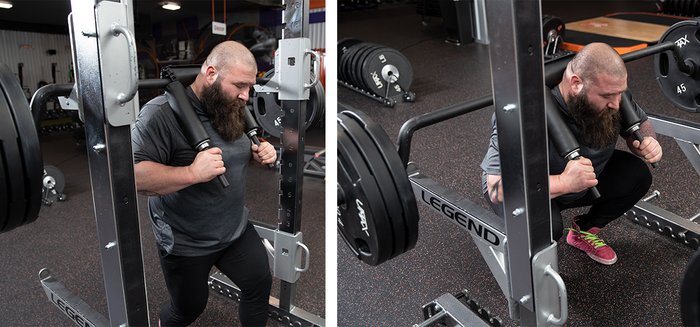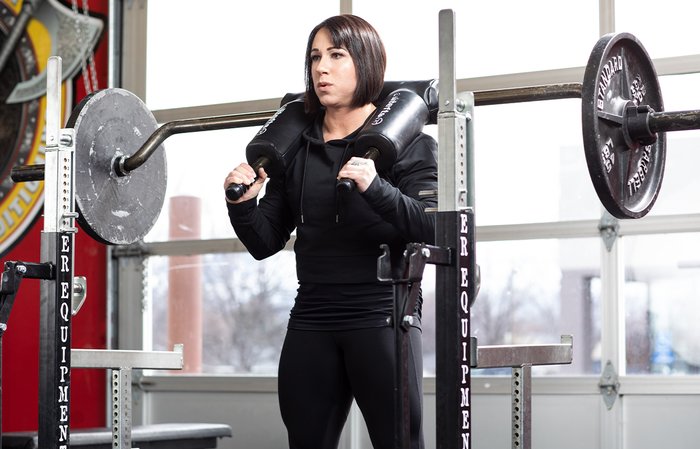There will always be a place for the standard barbell in every workout routine. Yet when it comes to the squat, many trainees struggle with safety—and effectiveness—for various reasons: poor positioning, limited mobility, past injury, you name it. This is where specialty bars can come in handy. I'm going to focus on the safety squat bar, aka the SSB, or Yoke bar.
The safety squat bar may look like it's pulled straight from a Viking village, but don't let it intimidate you. It offers a slew of benefits that can take your lower-body training to the next level, no matter your level. Squatting with it isn't necessarily harder or easier, it's simply another variation of the squat pattern to challenge your skill and strength.
The SSB is a versatile piece of equipment that can be used for all goals, whether you're teaching beginners, trying to put on size, or using it to improve technique for a training block or two.
Let's cover some of the benefits of using the SSB in more depth:
1. You Can Squat Even with an Upper-Body Injury
If you've suffered a shoulder or even a pec injury, you know how quickly your squat game is negatively affected—discomfort or pain experienced with a standard barbell compromises not only the injured area but also the overall movement pattern. It can reduce both the frequency and intensity of your training. The SSB padding sits comfortably on your traps and shoulders and keeps your hands on the handles in front of you, whereas the grip you use on a regular bar puts pressure on your shoulders.

2. You Can Use It During a Heavy Bench Program
It's extremely important to take care of your shoulders when you're on a heavy lifting program, particularly when you're pressing more frequently or pushing the weight. The safety squat bar enables you to make continued progress and keep overloading your squat as your pressing volume begins to trend up, without the added beating your shoulders would get from using a standard barbell.
3. It Can Help You Strengthen Specific Weaknesses
The SSB squat is actually a hybrid of the front and back squat that stimulates untapped growth and strength potential and is a plateau buster for squatting. You hit the upper back, core, hips, and posterior chain in a different way, bringing up weak points, and that will carry over to your deadlifts as well barbell squats and front squats.
Squatting technique differs slightly with this bar because of the way the weight is distributed. It dictates a more upright position, requiring more upper-back and core stabilization throughout the movement, which for some lifters can be a huge benefit if they struggle to remain tight and fail lifts because their chest is caving in.
4. It's Efficient
Bodybuilders and strength athletes alike will benefit from performing higher volume with this bar. It's great for quad development and overall training volume when you're trying to grow in size or strength. Using the SSB with lighter weight and higher reps contributes to size gains—the hand placement and weight distribution make for a much safer and more comfortable position, so you can get more reps, more growth, and put more weight on the bar.
Simply put, it adds variation to your training, providing the stimulus for you to break through plateaus and avoid injury.

5. It's a Versatile Tool That You Can Use for Other Exercise Variations
Although squatting is what the safety squat bar is known for, you can use it to perform variations of other accessory movements to strengthen and build your body even further:
- SSB Good Morning. The hand position in front is more comfortable and provides better stabilization of the bar on your shoulders, and there's no cramping in the upper back and shoulders as you hinge forward. Using the SSB also makes the movement more like a deadlift.
- Hatfield Squat. Here you're using your hands against the rack to maintain tension and position while "pulling" out of your sticking point. You can use Hatfield squats for both higher rep work and max-effort low-rep work. Either way, you will build confidence to load more weight and squat without the support of your hands on the bar.
- Front Rack Position. This load placement, almost identical to a regular front squat, leads to a cool new stimulus—great for strength as well as hypertrophic adaptations—and the padding and handles through the shoulders can make it a little more comfortable than a barbell across your neck. It is a little cumbersome, and loading heavy can sometimes be tricky, but for someone with poor wrist mobility or poor ability to protract the scapula fully, as needed for the rack position in a regular front squat, this can be a solid alternative.
6. It's a Tool for Single-Leg Work
Doing single-leg work using the SSB offers a new challenge on exercises you perform all the time—again, by forcing your body to adapt to the different weight distribution and strengthening weaknesses you may not otherwise notice.
A few of my favorite single-leg movements done with the SSB are Bulgarian split squats, single-leg Romanian deadlifts, and step-ups.
The safety squat bar is awesome, plain and simple. If it's not in your current training program, it should be, switched out for some of your lower-body work if you want to unlock hidden gains. Some people may not have access to a speciality bar like this one, in which case using something like a belt squat can offer a similar position, or adding straps or towels across the bar to hang on to, although loading will be compromised due to the lack of stability.
Let's get to work.
Bodybuilding.com All Access contains more than 50 expert-crafted workout plans that incorporate these sorts of training strategies and more! Join today and begin the plan that's right for you!

